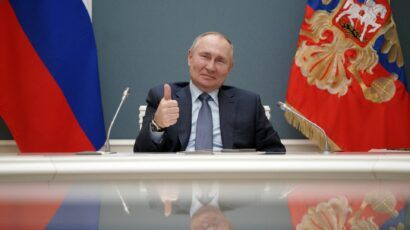Open secret
By Francesco Calogero, Giorgio La Malfa | March 19, 2012
At the peak of the Cold War, more than 7,000 and as many as 24 different types of tactical — or nonstrategic — nuclear weapons were deployed by the United States through the NATO framework in Europe. The role of the weapons was to buttress deterrence of a Soviet military strike by countering the perception that, after the Warsaw Pact, NATO conventional forces were inferior to Soviet conventional forces. Some of the US tactical nuclear weapons — which were stationed in Belgium, Germany, Greece, Italy, Netherlands, Turkey, and the United Kingdom — are still there.
Back then, NATO’s official policy was that European government officials should neither confirm nor deny the presence of US tactical nuclear weapons in their countries. Understandably, NATO wanted to make it difficult for the Soviet Union and other Warsaw Pact states to know the location, size, or extent of its defensive assets. The policy was probably also meant to deter any pacifist groups from concentrating their efforts or protests in sensitive areas.
With the end of the Cold War, however, the geopolitical situation radically changed. And the neither-confirm-nor-deny policy hasn’t stopped the international community from learning a lot about the US arsenal in Europe. The number, quality, and readiness status of the US tactical nuclear weapons deployed in NATO countries have been drastically reduced: Less than a few hundred US weapons are now deployed overseas. There is also now only one type of weapon: gravity bombs, which are assigned, under double-key arrangements, to US and host-country aircrafts now based in Belgium, Germany, Italy, the Netherlands, and Turkey. (The US nuclear weapons that were based in the United Kingdom and Greece have already been withdrawn.) Reliable NATO sources say the readiness status of these nuclear weapons has gradually decreased — from less than an hour during the Cold War to months of prep time now. Obviously these weapons no longer play any significant military role. Plus, the entire global nuclear regime is aware of them, and yet the NATO policy of neither confirming nor denying their presence prevails.
In its recent New Strategic Concept, NATO avoided addressing both why these US Cold War relics are still useful and under what circumstance it would be necessary to deploy them. Russia keeps a few thousand tactical nuclear weapons on its territory, too, their purported military justification being that the tactical nuclear weapons compensate for the superiority of NATO’s conventional armaments — a change from the Warsaw Pact days, when the Soviets’ conventional weapons were perceived as superior. Presumably, a move from the United States to completely withdraw its tactical nuclear weapons from Europe would, in turn, encourage Russia to move its own far from the Western borders. Unfortunately, it’s more complicated than that: Some new NATO members are clamoring for reassurance that the United States will remain committed to their security vis-à-vis their Russian neighbor. The presence of US tactical nuclear weapons in Europe is still deemed by many to have a significant symbolic role in the region, no matter the weapons’ actual military relevance.
Nevertheless, soon NATO will have to deal with the matter of the US weapons in Europe. Some of the host countries — Germany, the Netherlands, and Belgium — have made it clear that they would like to see the withdrawal of the US weapons from their nations. NATO’s removal of all or some of the US tactical nuclear weapons would reinforce the worldwide nuclear weapon nonproliferation regime by acknowledging the waning military salience of nuclear weaponry — and it would reaffirm America’s commitment to nonproliferation and to President Obama’s vision of a nuclear-free world, which he outlined in his 2009 Prague speech. It would also give NATO an opportunity to establish a universal convention that land-based nuclear weapons only be stored or deployed from within the country that has ownership over them.
But, even before dealing with the question of tactical nuclear weapon withdrawal — which will require a struggle for consensus within NATO — it would be smart to revise the neither-confirm-nor-deny secrecy policy. NATO is currently working on the Defense and Deterrence Posture Review, providing an excellent moment to eliminate this anachronism from the Cold War and dispense with the neither-confirm-nor-deny charade. Until the complete withdrawal of all US tactical nuclear weapons from Europe, NATO should announce the exact numbers of tactical nuclear weapons, name all of the countries in Europe that have them, and give details about where they are stationed. This would allow, and even encourage, NATO members to have a more open, frank, and democratic discussion of the pros and cons of the continued presence of these US weapons — rather than continuing to operate under the pretense that no one knows which countries have the weapons. Such a move would also be in keeping with the more transparent nuclear weapon policy presented in the recent US Nuclear Posture Review and endorsed by NATO’s Strategic Concept. But the current opacity of NATO policy on nuclear weaponry is inconsistent with its own principles and its advocacy of clearer nuclear postures by other nuclear weapon states — particularly in Russia and China.
NATO has a chance to make this happen in the upcoming Defense and Deterrence Posture Review. A candid dialogue about nuclear issues will only bolster NATO’s credibility in its work toward nonproliferation. If a nuclear weapons-free world is what NATO truly wants, full disclosure is the first step.
Together, we make the world safer.
The Bulletin elevates expert voices above the noise. But as an independent nonprofit organization, our operations depend on the support of readers like you. Help us continue to deliver quality journalism that holds leaders accountable. Your support of our work at any level is important. In return, we promise our coverage will be understandable, influential, vigilant, solution-oriented, and fair-minded. Together we can make a difference.
Topics: Nuclear Weapons, Opinion















